Critical Analysis of Case Study
VerifiedAdded on 2023/01/18
|10
|3115
|37
AI Summary
This paper critically analyzes a case study of a patient with diabetes and a foot ulcer, focusing on the priority of care and the pathophysiology of the condition. The goal is to manage the patient's blood glucose level and treat the wound infection. Nursing interventions include diet planning, medication, wound debridement, and proper dressing. The outcome will be evaluated in 15-day intervals for 6 months.
Contribute Materials
Your contribution can guide someone’s learning journey. Share your
documents today.
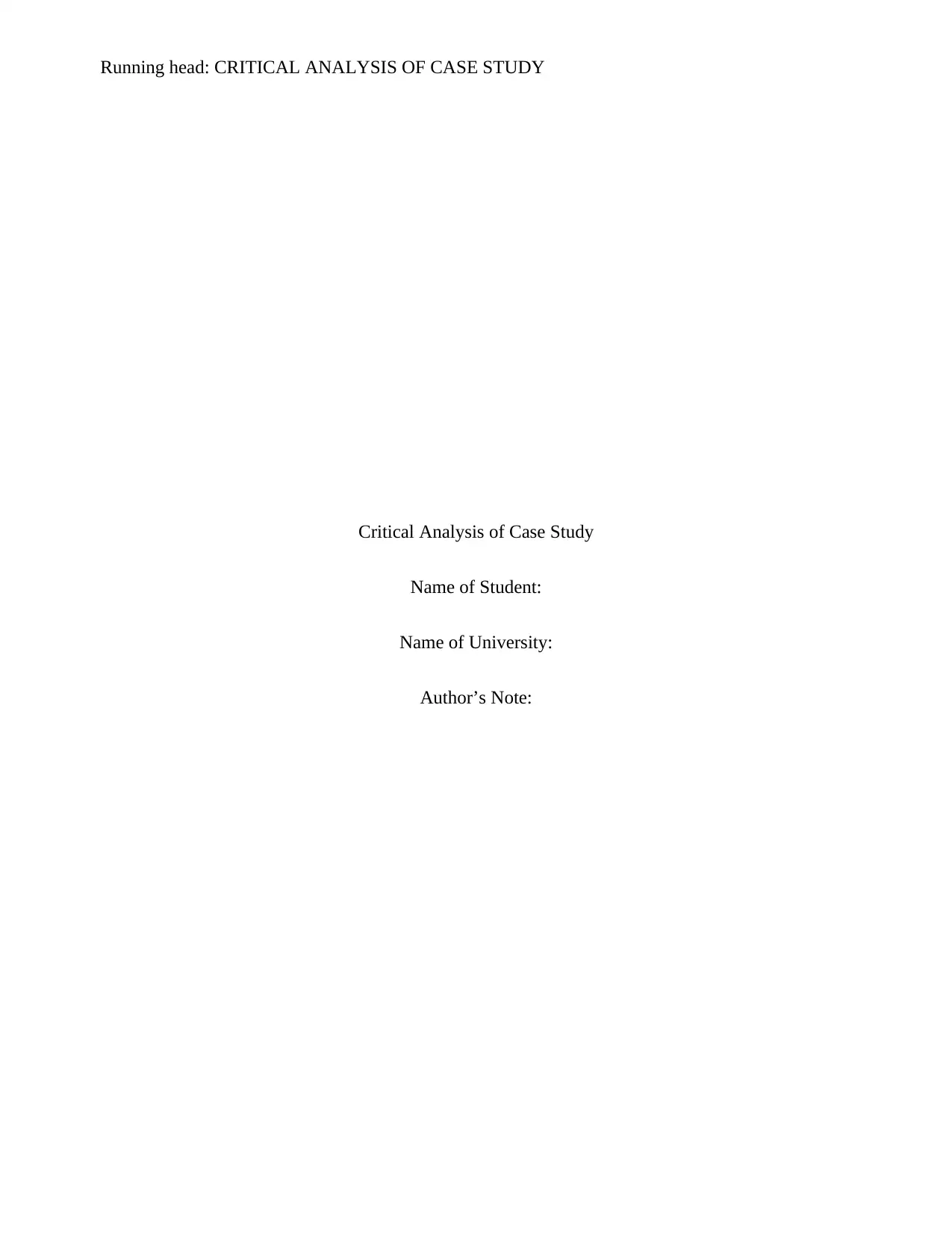
Running head: CRITICAL ANALYSIS OF CASE STUDY
Critical Analysis of Case Study
Name of Student:
Name of University:
Author’s Note:
Critical Analysis of Case Study
Name of Student:
Name of University:
Author’s Note:
Secure Best Marks with AI Grader
Need help grading? Try our AI Grader for instant feedback on your assignments.
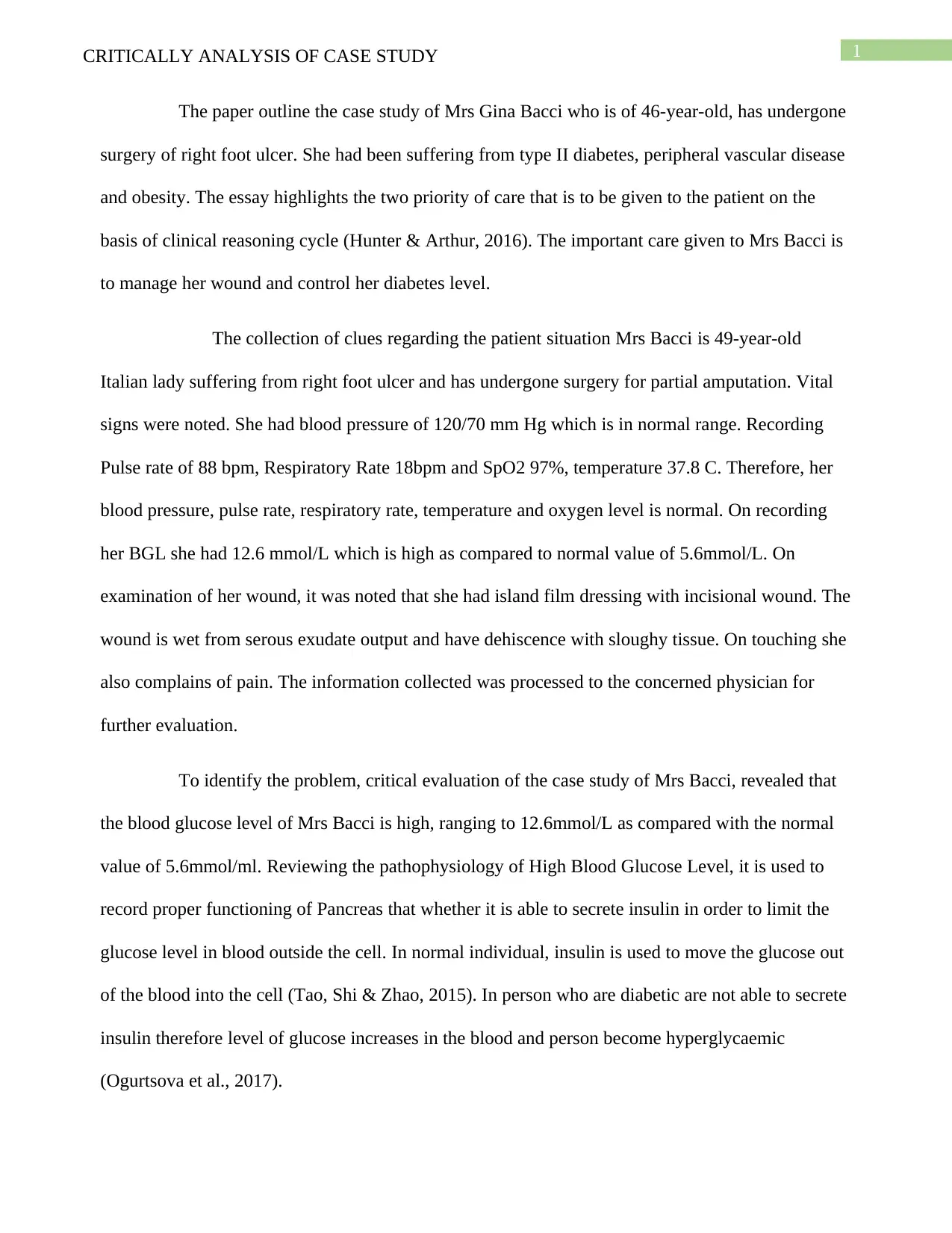
1CRITICALLY ANALYSIS OF CASE STUDY
The paper outline the case study of Mrs Gina Bacci who is of 46-year-old, has undergone
surgery of right foot ulcer. She had been suffering from type II diabetes, peripheral vascular disease
and obesity. The essay highlights the two priority of care that is to be given to the patient on the
basis of clinical reasoning cycle (Hunter & Arthur, 2016). The important care given to Mrs Bacci is
to manage her wound and control her diabetes level.
The collection of clues regarding the patient situation Mrs Bacci is 49-year-old
Italian lady suffering from right foot ulcer and has undergone surgery for partial amputation. Vital
signs were noted. She had blood pressure of 120/70 mm Hg which is in normal range. Recording
Pulse rate of 88 bpm, Respiratory Rate 18bpm and SpO2 97%, temperature 37.8 C. Therefore, her
blood pressure, pulse rate, respiratory rate, temperature and oxygen level is normal. On recording
her BGL she had 12.6 mmol/L which is high as compared to normal value of 5.6mmol/L. On
examination of her wound, it was noted that she had island film dressing with incisional wound. The
wound is wet from serous exudate output and have dehiscence with sloughy tissue. On touching she
also complains of pain. The information collected was processed to the concerned physician for
further evaluation.
To identify the problem, critical evaluation of the case study of Mrs Bacci, revealed that
the blood glucose level of Mrs Bacci is high, ranging to 12.6mmol/L as compared with the normal
value of 5.6mmol/ml. Reviewing the pathophysiology of High Blood Glucose Level, it is used to
record proper functioning of Pancreas that whether it is able to secrete insulin in order to limit the
glucose level in blood outside the cell. In normal individual, insulin is used to move the glucose out
of the blood into the cell (Tao, Shi & Zhao, 2015). In person who are diabetic are not able to secrete
insulin therefore level of glucose increases in the blood and person become hyperglycaemic
(Ogurtsova et al., 2017).
The paper outline the case study of Mrs Gina Bacci who is of 46-year-old, has undergone
surgery of right foot ulcer. She had been suffering from type II diabetes, peripheral vascular disease
and obesity. The essay highlights the two priority of care that is to be given to the patient on the
basis of clinical reasoning cycle (Hunter & Arthur, 2016). The important care given to Mrs Bacci is
to manage her wound and control her diabetes level.
The collection of clues regarding the patient situation Mrs Bacci is 49-year-old
Italian lady suffering from right foot ulcer and has undergone surgery for partial amputation. Vital
signs were noted. She had blood pressure of 120/70 mm Hg which is in normal range. Recording
Pulse rate of 88 bpm, Respiratory Rate 18bpm and SpO2 97%, temperature 37.8 C. Therefore, her
blood pressure, pulse rate, respiratory rate, temperature and oxygen level is normal. On recording
her BGL she had 12.6 mmol/L which is high as compared to normal value of 5.6mmol/L. On
examination of her wound, it was noted that she had island film dressing with incisional wound. The
wound is wet from serous exudate output and have dehiscence with sloughy tissue. On touching she
also complains of pain. The information collected was processed to the concerned physician for
further evaluation.
To identify the problem, critical evaluation of the case study of Mrs Bacci, revealed that
the blood glucose level of Mrs Bacci is high, ranging to 12.6mmol/L as compared with the normal
value of 5.6mmol/ml. Reviewing the pathophysiology of High Blood Glucose Level, it is used to
record proper functioning of Pancreas that whether it is able to secrete insulin in order to limit the
glucose level in blood outside the cell. In normal individual, insulin is used to move the glucose out
of the blood into the cell (Tao, Shi & Zhao, 2015). In person who are diabetic are not able to secrete
insulin therefore level of glucose increases in the blood and person become hyperglycaemic
(Ogurtsova et al., 2017).
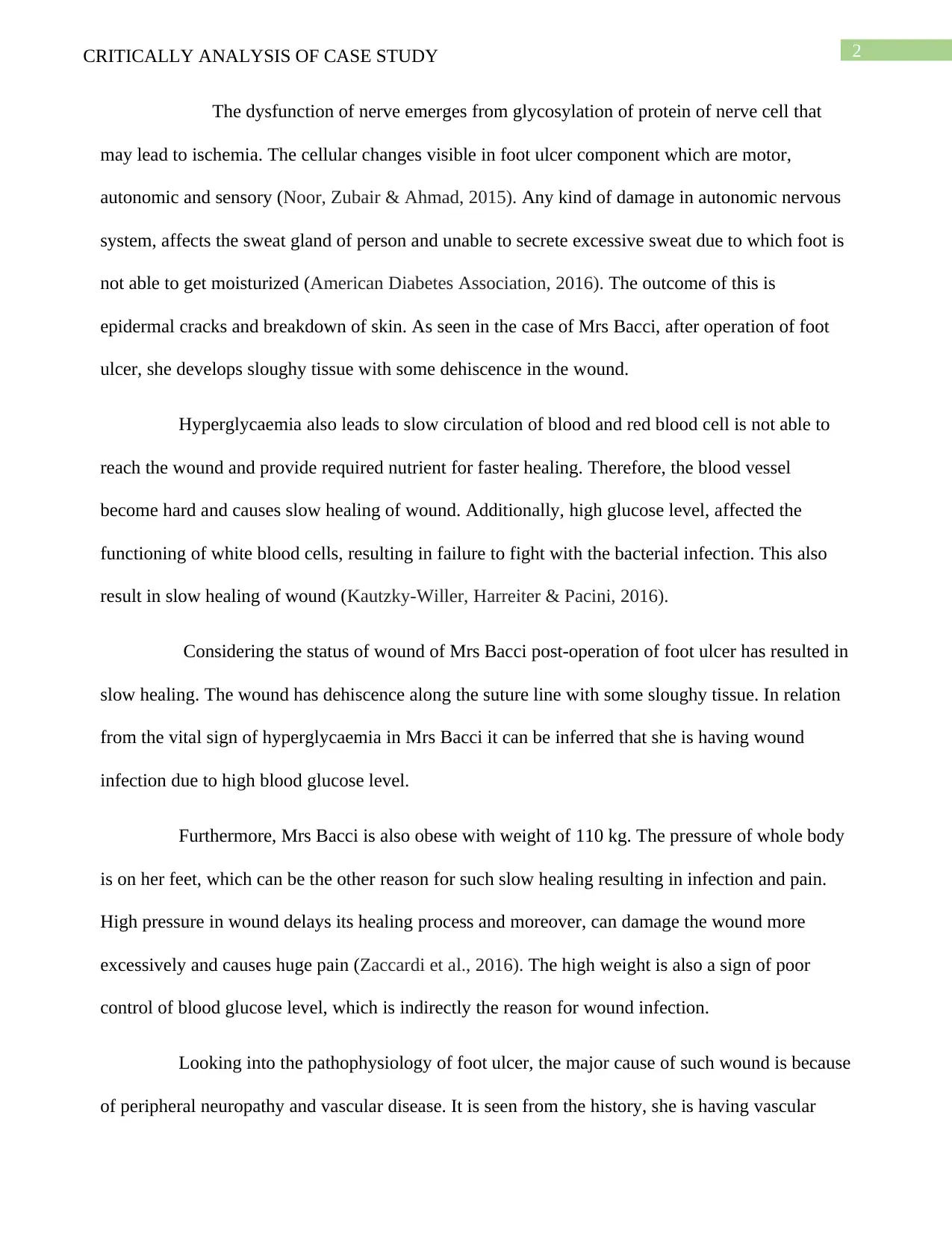
2CRITICALLY ANALYSIS OF CASE STUDY
The dysfunction of nerve emerges from glycosylation of protein of nerve cell that
may lead to ischemia. The cellular changes visible in foot ulcer component which are motor,
autonomic and sensory (Noor, Zubair & Ahmad, 2015). Any kind of damage in autonomic nervous
system, affects the sweat gland of person and unable to secrete excessive sweat due to which foot is
not able to get moisturized (American Diabetes Association, 2016). The outcome of this is
epidermal cracks and breakdown of skin. As seen in the case of Mrs Bacci, after operation of foot
ulcer, she develops sloughy tissue with some dehiscence in the wound.
Hyperglycaemia also leads to slow circulation of blood and red blood cell is not able to
reach the wound and provide required nutrient for faster healing. Therefore, the blood vessel
become hard and causes slow healing of wound. Additionally, high glucose level, affected the
functioning of white blood cells, resulting in failure to fight with the bacterial infection. This also
result in slow healing of wound (Kautzky-Willer, Harreiter & Pacini, 2016).
Considering the status of wound of Mrs Bacci post-operation of foot ulcer has resulted in
slow healing. The wound has dehiscence along the suture line with some sloughy tissue. In relation
from the vital sign of hyperglycaemia in Mrs Bacci it can be inferred that she is having wound
infection due to high blood glucose level.
Furthermore, Mrs Bacci is also obese with weight of 110 kg. The pressure of whole body
is on her feet, which can be the other reason for such slow healing resulting in infection and pain.
High pressure in wound delays its healing process and moreover, can damage the wound more
excessively and causes huge pain (Zaccardi et al., 2016). The high weight is also a sign of poor
control of blood glucose level, which is indirectly the reason for wound infection.
Looking into the pathophysiology of foot ulcer, the major cause of such wound is because
of peripheral neuropathy and vascular disease. It is seen from the history, she is having vascular
The dysfunction of nerve emerges from glycosylation of protein of nerve cell that
may lead to ischemia. The cellular changes visible in foot ulcer component which are motor,
autonomic and sensory (Noor, Zubair & Ahmad, 2015). Any kind of damage in autonomic nervous
system, affects the sweat gland of person and unable to secrete excessive sweat due to which foot is
not able to get moisturized (American Diabetes Association, 2016). The outcome of this is
epidermal cracks and breakdown of skin. As seen in the case of Mrs Bacci, after operation of foot
ulcer, she develops sloughy tissue with some dehiscence in the wound.
Hyperglycaemia also leads to slow circulation of blood and red blood cell is not able to
reach the wound and provide required nutrient for faster healing. Therefore, the blood vessel
become hard and causes slow healing of wound. Additionally, high glucose level, affected the
functioning of white blood cells, resulting in failure to fight with the bacterial infection. This also
result in slow healing of wound (Kautzky-Willer, Harreiter & Pacini, 2016).
Considering the status of wound of Mrs Bacci post-operation of foot ulcer has resulted in
slow healing. The wound has dehiscence along the suture line with some sloughy tissue. In relation
from the vital sign of hyperglycaemia in Mrs Bacci it can be inferred that she is having wound
infection due to high blood glucose level.
Furthermore, Mrs Bacci is also obese with weight of 110 kg. The pressure of whole body
is on her feet, which can be the other reason for such slow healing resulting in infection and pain.
High pressure in wound delays its healing process and moreover, can damage the wound more
excessively and causes huge pain (Zaccardi et al., 2016). The high weight is also a sign of poor
control of blood glucose level, which is indirectly the reason for wound infection.
Looking into the pathophysiology of foot ulcer, the major cause of such wound is because
of peripheral neuropathy and vascular disease. It is seen from the history, she is having vascular
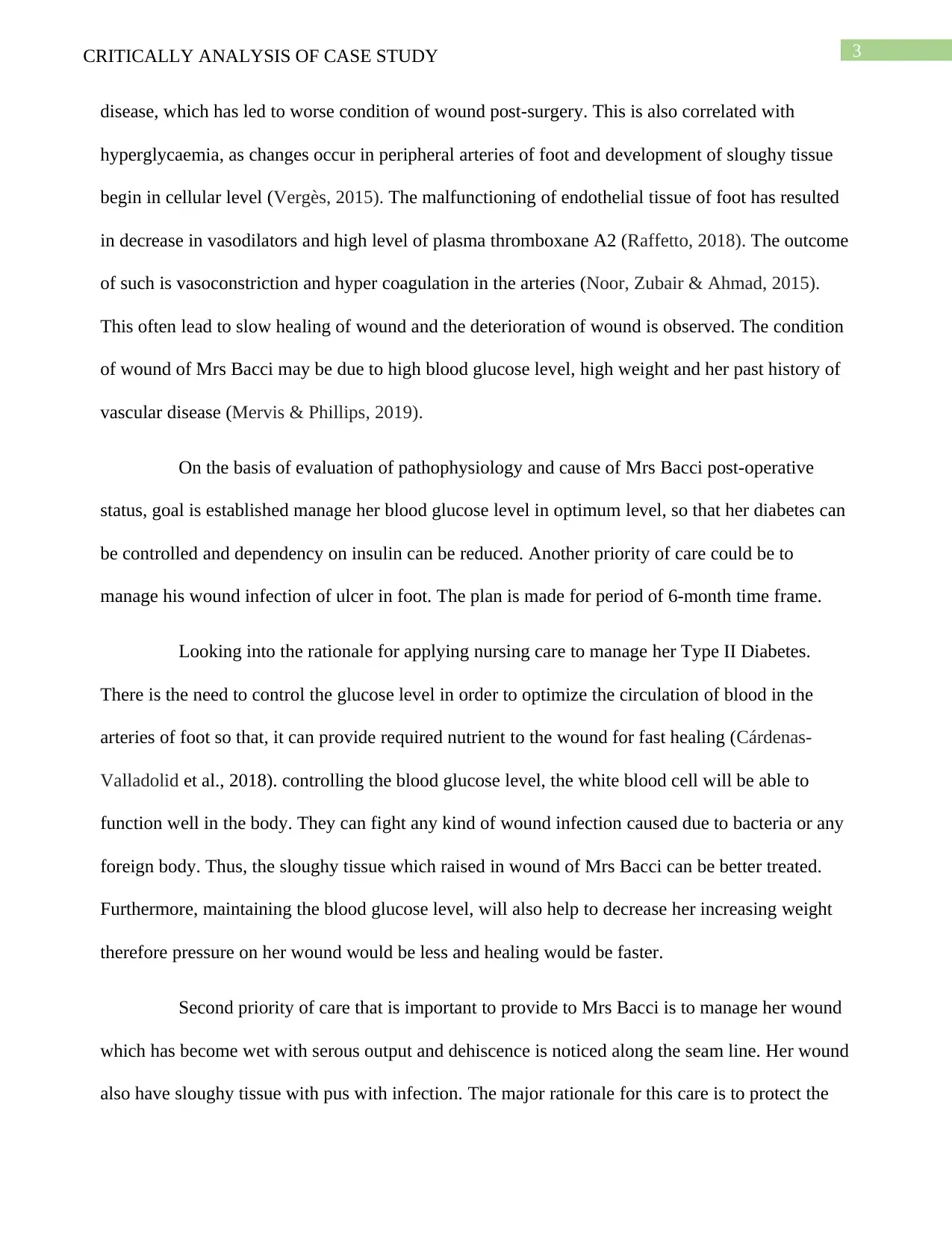
3CRITICALLY ANALYSIS OF CASE STUDY
disease, which has led to worse condition of wound post-surgery. This is also correlated with
hyperglycaemia, as changes occur in peripheral arteries of foot and development of sloughy tissue
begin in cellular level (Vergès, 2015). The malfunctioning of endothelial tissue of foot has resulted
in decrease in vasodilators and high level of plasma thromboxane A2 (Raffetto, 2018). The outcome
of such is vasoconstriction and hyper coagulation in the arteries (Noor, Zubair & Ahmad, 2015).
This often lead to slow healing of wound and the deterioration of wound is observed. The condition
of wound of Mrs Bacci may be due to high blood glucose level, high weight and her past history of
vascular disease (Mervis & Phillips, 2019).
On the basis of evaluation of pathophysiology and cause of Mrs Bacci post-operative
status, goal is established manage her blood glucose level in optimum level, so that her diabetes can
be controlled and dependency on insulin can be reduced. Another priority of care could be to
manage his wound infection of ulcer in foot. The plan is made for period of 6-month time frame.
Looking into the rationale for applying nursing care to manage her Type II Diabetes.
There is the need to control the glucose level in order to optimize the circulation of blood in the
arteries of foot so that, it can provide required nutrient to the wound for fast healing (Cárdenas-
Valladolid et al., 2018). controlling the blood glucose level, the white blood cell will be able to
function well in the body. They can fight any kind of wound infection caused due to bacteria or any
foreign body. Thus, the sloughy tissue which raised in wound of Mrs Bacci can be better treated.
Furthermore, maintaining the blood glucose level, will also help to decrease her increasing weight
therefore pressure on her wound would be less and healing would be faster.
Second priority of care that is important to provide to Mrs Bacci is to manage her wound
which has become wet with serous output and dehiscence is noticed along the seam line. Her wound
also have sloughy tissue with pus with infection. The major rationale for this care is to protect the
disease, which has led to worse condition of wound post-surgery. This is also correlated with
hyperglycaemia, as changes occur in peripheral arteries of foot and development of sloughy tissue
begin in cellular level (Vergès, 2015). The malfunctioning of endothelial tissue of foot has resulted
in decrease in vasodilators and high level of plasma thromboxane A2 (Raffetto, 2018). The outcome
of such is vasoconstriction and hyper coagulation in the arteries (Noor, Zubair & Ahmad, 2015).
This often lead to slow healing of wound and the deterioration of wound is observed. The condition
of wound of Mrs Bacci may be due to high blood glucose level, high weight and her past history of
vascular disease (Mervis & Phillips, 2019).
On the basis of evaluation of pathophysiology and cause of Mrs Bacci post-operative
status, goal is established manage her blood glucose level in optimum level, so that her diabetes can
be controlled and dependency on insulin can be reduced. Another priority of care could be to
manage his wound infection of ulcer in foot. The plan is made for period of 6-month time frame.
Looking into the rationale for applying nursing care to manage her Type II Diabetes.
There is the need to control the glucose level in order to optimize the circulation of blood in the
arteries of foot so that, it can provide required nutrient to the wound for fast healing (Cárdenas-
Valladolid et al., 2018). controlling the blood glucose level, the white blood cell will be able to
function well in the body. They can fight any kind of wound infection caused due to bacteria or any
foreign body. Thus, the sloughy tissue which raised in wound of Mrs Bacci can be better treated.
Furthermore, maintaining the blood glucose level, will also help to decrease her increasing weight
therefore pressure on her wound would be less and healing would be faster.
Second priority of care that is important to provide to Mrs Bacci is to manage her wound
which has become wet with serous output and dehiscence is noticed along the seam line. Her wound
also have sloughy tissue with pus with infection. The major rationale for this care is to protect the
Secure Best Marks with AI Grader
Need help grading? Try our AI Grader for instant feedback on your assignments.
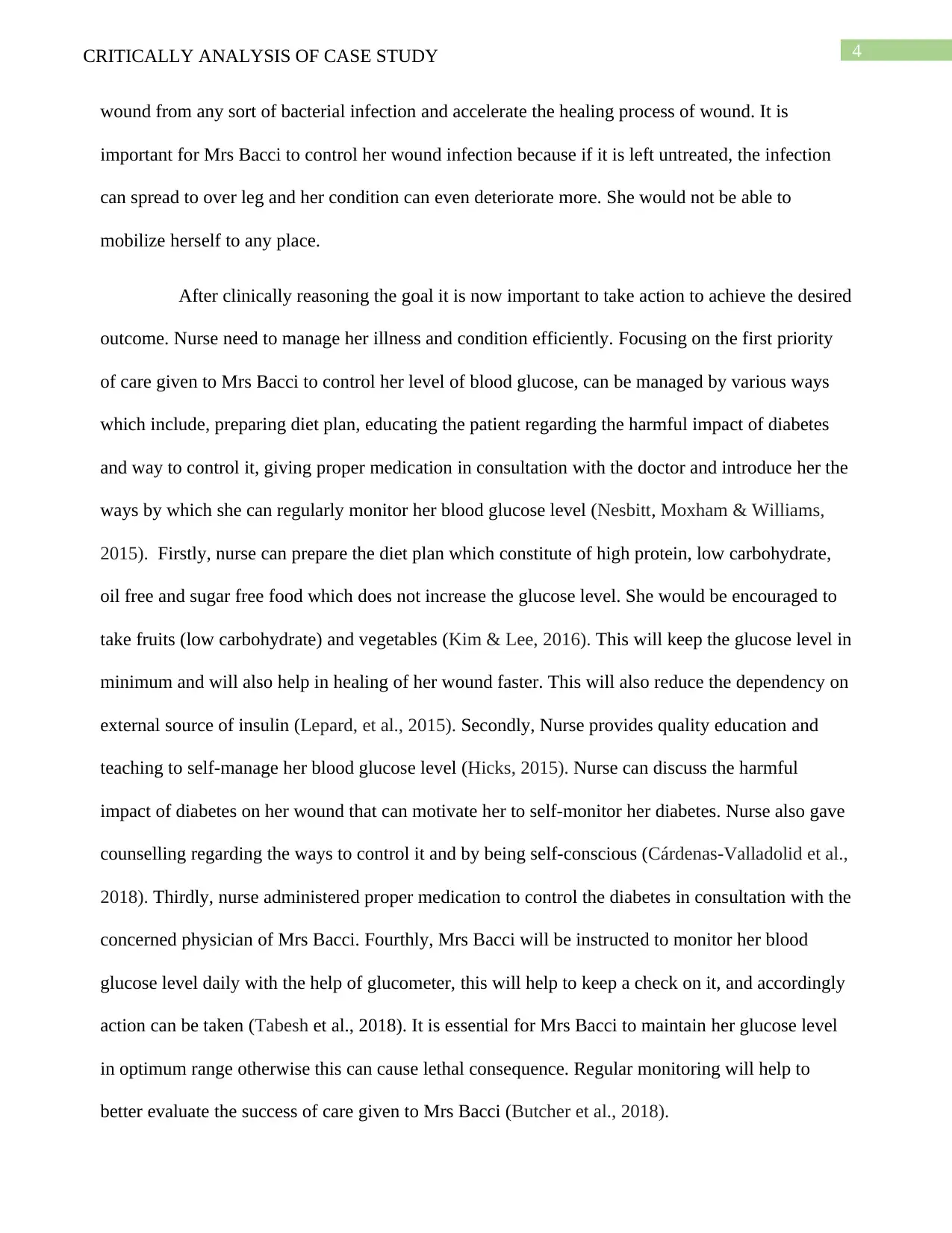
4CRITICALLY ANALYSIS OF CASE STUDY
wound from any sort of bacterial infection and accelerate the healing process of wound. It is
important for Mrs Bacci to control her wound infection because if it is left untreated, the infection
can spread to over leg and her condition can even deteriorate more. She would not be able to
mobilize herself to any place.
After clinically reasoning the goal it is now important to take action to achieve the desired
outcome. Nurse need to manage her illness and condition efficiently. Focusing on the first priority
of care given to Mrs Bacci to control her level of blood glucose, can be managed by various ways
which include, preparing diet plan, educating the patient regarding the harmful impact of diabetes
and way to control it, giving proper medication in consultation with the doctor and introduce her the
ways by which she can regularly monitor her blood glucose level (Nesbitt, Moxham & Williams,
2015). Firstly, nurse can prepare the diet plan which constitute of high protein, low carbohydrate,
oil free and sugar free food which does not increase the glucose level. She would be encouraged to
take fruits (low carbohydrate) and vegetables (Kim & Lee, 2016). This will keep the glucose level in
minimum and will also help in healing of her wound faster. This will also reduce the dependency on
external source of insulin (Lepard, et al., 2015). Secondly, Nurse provides quality education and
teaching to self-manage her blood glucose level (Hicks, 2015). Nurse can discuss the harmful
impact of diabetes on her wound that can motivate her to self-monitor her diabetes. Nurse also gave
counselling regarding the ways to control it and by being self-conscious (Cárdenas-Valladolid et al.,
2018). Thirdly, nurse administered proper medication to control the diabetes in consultation with the
concerned physician of Mrs Bacci. Fourthly, Mrs Bacci will be instructed to monitor her blood
glucose level daily with the help of glucometer, this will help to keep a check on it, and accordingly
action can be taken (Tabesh et al., 2018). It is essential for Mrs Bacci to maintain her glucose level
in optimum range otherwise this can cause lethal consequence. Regular monitoring will help to
better evaluate the success of care given to Mrs Bacci (Butcher et al., 2018).
wound from any sort of bacterial infection and accelerate the healing process of wound. It is
important for Mrs Bacci to control her wound infection because if it is left untreated, the infection
can spread to over leg and her condition can even deteriorate more. She would not be able to
mobilize herself to any place.
After clinically reasoning the goal it is now important to take action to achieve the desired
outcome. Nurse need to manage her illness and condition efficiently. Focusing on the first priority
of care given to Mrs Bacci to control her level of blood glucose, can be managed by various ways
which include, preparing diet plan, educating the patient regarding the harmful impact of diabetes
and way to control it, giving proper medication in consultation with the doctor and introduce her the
ways by which she can regularly monitor her blood glucose level (Nesbitt, Moxham & Williams,
2015). Firstly, nurse can prepare the diet plan which constitute of high protein, low carbohydrate,
oil free and sugar free food which does not increase the glucose level. She would be encouraged to
take fruits (low carbohydrate) and vegetables (Kim & Lee, 2016). This will keep the glucose level in
minimum and will also help in healing of her wound faster. This will also reduce the dependency on
external source of insulin (Lepard, et al., 2015). Secondly, Nurse provides quality education and
teaching to self-manage her blood glucose level (Hicks, 2015). Nurse can discuss the harmful
impact of diabetes on her wound that can motivate her to self-monitor her diabetes. Nurse also gave
counselling regarding the ways to control it and by being self-conscious (Cárdenas-Valladolid et al.,
2018). Thirdly, nurse administered proper medication to control the diabetes in consultation with the
concerned physician of Mrs Bacci. Fourthly, Mrs Bacci will be instructed to monitor her blood
glucose level daily with the help of glucometer, this will help to keep a check on it, and accordingly
action can be taken (Tabesh et al., 2018). It is essential for Mrs Bacci to maintain her glucose level
in optimum range otherwise this can cause lethal consequence. Regular monitoring will help to
better evaluate the success of care given to Mrs Bacci (Butcher et al., 2018).
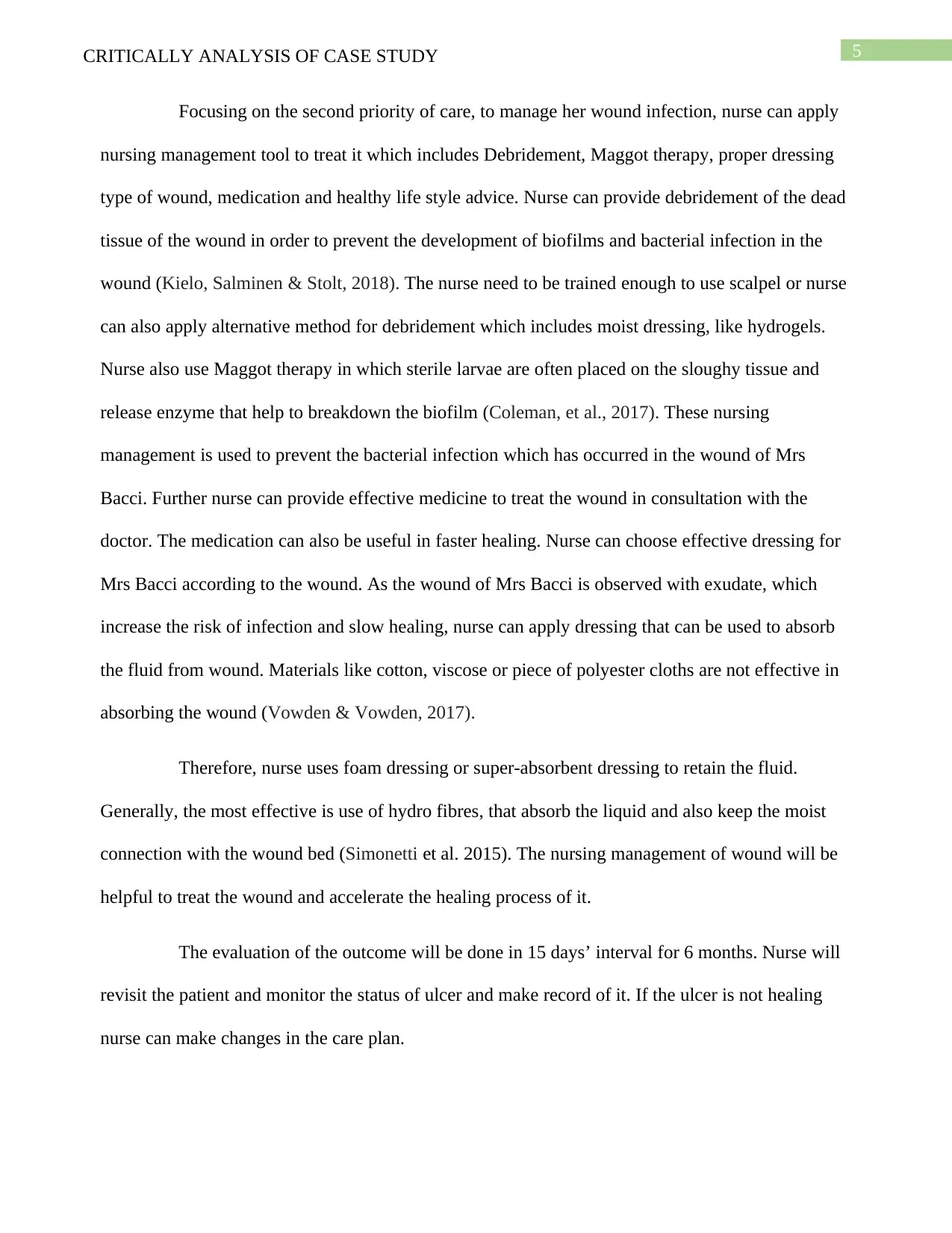
5CRITICALLY ANALYSIS OF CASE STUDY
Focusing on the second priority of care, to manage her wound infection, nurse can apply
nursing management tool to treat it which includes Debridement, Maggot therapy, proper dressing
type of wound, medication and healthy life style advice. Nurse can provide debridement of the dead
tissue of the wound in order to prevent the development of biofilms and bacterial infection in the
wound (Kielo, Salminen & Stolt, 2018). The nurse need to be trained enough to use scalpel or nurse
can also apply alternative method for debridement which includes moist dressing, like hydrogels.
Nurse also use Maggot therapy in which sterile larvae are often placed on the sloughy tissue and
release enzyme that help to breakdown the biofilm (Coleman, et al., 2017). These nursing
management is used to prevent the bacterial infection which has occurred in the wound of Mrs
Bacci. Further nurse can provide effective medicine to treat the wound in consultation with the
doctor. The medication can also be useful in faster healing. Nurse can choose effective dressing for
Mrs Bacci according to the wound. As the wound of Mrs Bacci is observed with exudate, which
increase the risk of infection and slow healing, nurse can apply dressing that can be used to absorb
the fluid from wound. Materials like cotton, viscose or piece of polyester cloths are not effective in
absorbing the wound (Vowden & Vowden, 2017).
Therefore, nurse uses foam dressing or super-absorbent dressing to retain the fluid.
Generally, the most effective is use of hydro fibres, that absorb the liquid and also keep the moist
connection with the wound bed (Simonetti et al. 2015). The nursing management of wound will be
helpful to treat the wound and accelerate the healing process of it.
The evaluation of the outcome will be done in 15 days’ interval for 6 months. Nurse will
revisit the patient and monitor the status of ulcer and make record of it. If the ulcer is not healing
nurse can make changes in the care plan.
Focusing on the second priority of care, to manage her wound infection, nurse can apply
nursing management tool to treat it which includes Debridement, Maggot therapy, proper dressing
type of wound, medication and healthy life style advice. Nurse can provide debridement of the dead
tissue of the wound in order to prevent the development of biofilms and bacterial infection in the
wound (Kielo, Salminen & Stolt, 2018). The nurse need to be trained enough to use scalpel or nurse
can also apply alternative method for debridement which includes moist dressing, like hydrogels.
Nurse also use Maggot therapy in which sterile larvae are often placed on the sloughy tissue and
release enzyme that help to breakdown the biofilm (Coleman, et al., 2017). These nursing
management is used to prevent the bacterial infection which has occurred in the wound of Mrs
Bacci. Further nurse can provide effective medicine to treat the wound in consultation with the
doctor. The medication can also be useful in faster healing. Nurse can choose effective dressing for
Mrs Bacci according to the wound. As the wound of Mrs Bacci is observed with exudate, which
increase the risk of infection and slow healing, nurse can apply dressing that can be used to absorb
the fluid from wound. Materials like cotton, viscose or piece of polyester cloths are not effective in
absorbing the wound (Vowden & Vowden, 2017).
Therefore, nurse uses foam dressing or super-absorbent dressing to retain the fluid.
Generally, the most effective is use of hydro fibres, that absorb the liquid and also keep the moist
connection with the wound bed (Simonetti et al. 2015). The nursing management of wound will be
helpful to treat the wound and accelerate the healing process of it.
The evaluation of the outcome will be done in 15 days’ interval for 6 months. Nurse will
revisit the patient and monitor the status of ulcer and make record of it. If the ulcer is not healing
nurse can make changes in the care plan.
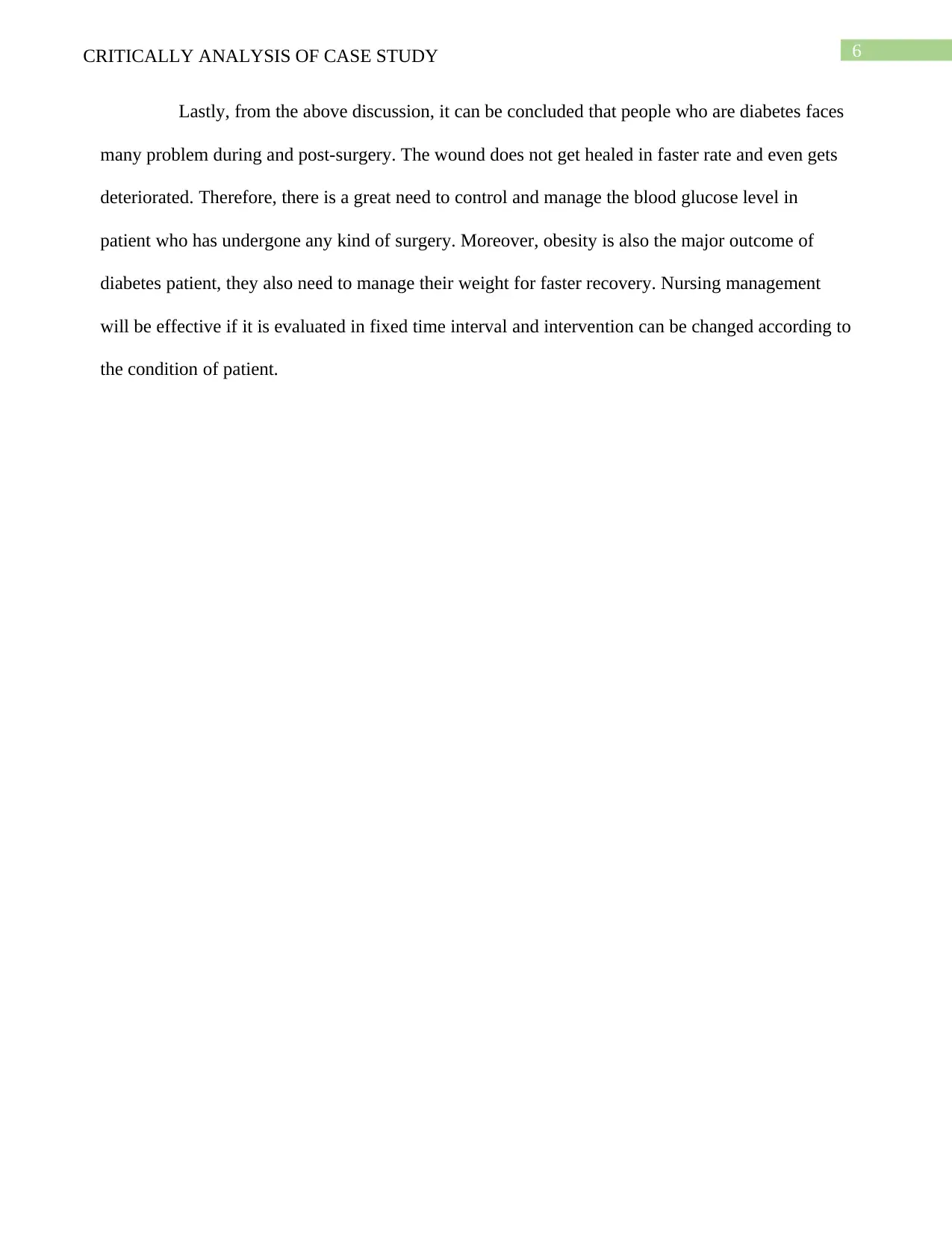
6CRITICALLY ANALYSIS OF CASE STUDY
Lastly, from the above discussion, it can be concluded that people who are diabetes faces
many problem during and post-surgery. The wound does not get healed in faster rate and even gets
deteriorated. Therefore, there is a great need to control and manage the blood glucose level in
patient who has undergone any kind of surgery. Moreover, obesity is also the major outcome of
diabetes patient, they also need to manage their weight for faster recovery. Nursing management
will be effective if it is evaluated in fixed time interval and intervention can be changed according to
the condition of patient.
Lastly, from the above discussion, it can be concluded that people who are diabetes faces
many problem during and post-surgery. The wound does not get healed in faster rate and even gets
deteriorated. Therefore, there is a great need to control and manage the blood glucose level in
patient who has undergone any kind of surgery. Moreover, obesity is also the major outcome of
diabetes patient, they also need to manage their weight for faster recovery. Nursing management
will be effective if it is evaluated in fixed time interval and intervention can be changed according to
the condition of patient.
Paraphrase This Document
Need a fresh take? Get an instant paraphrase of this document with our AI Paraphraser
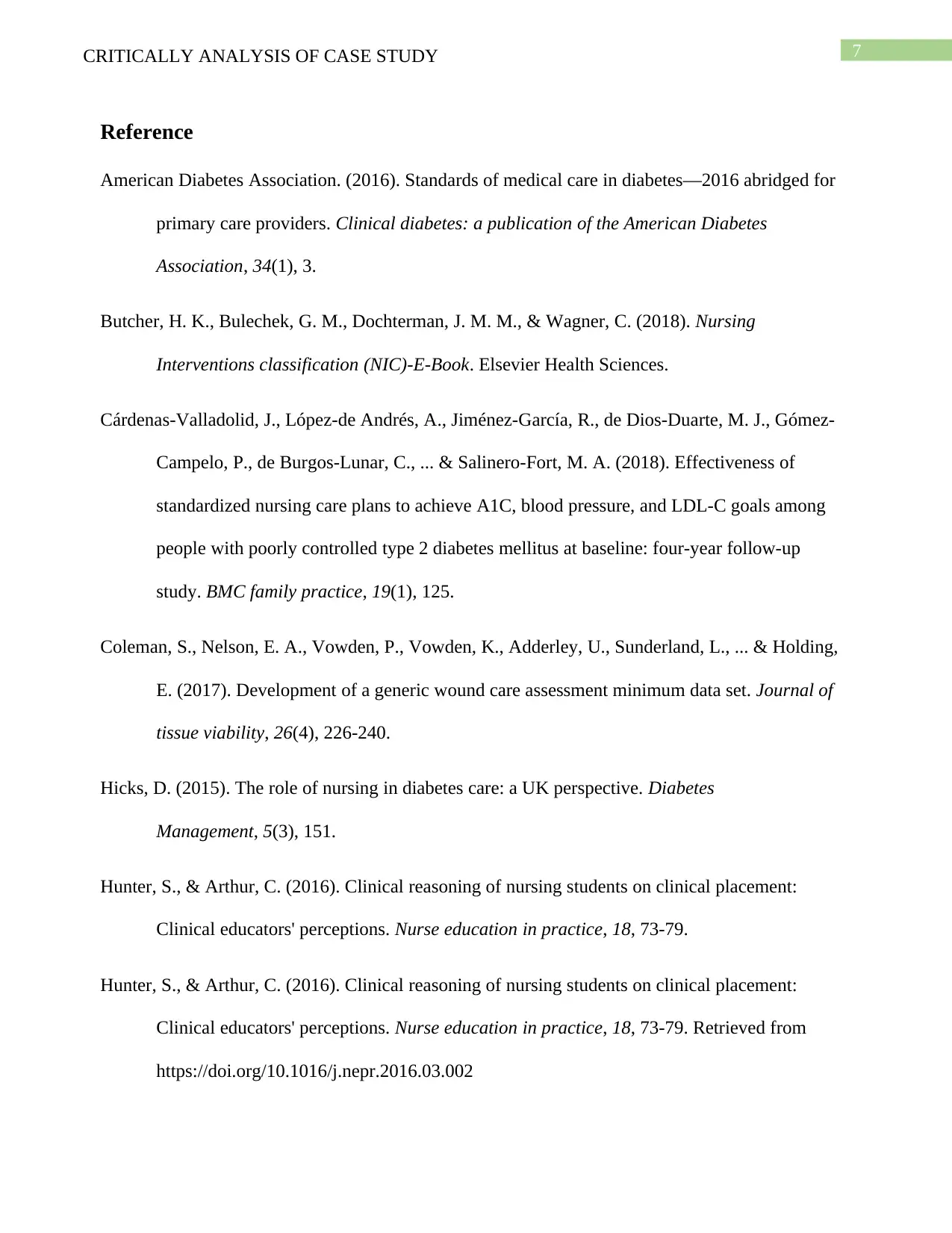
7CRITICALLY ANALYSIS OF CASE STUDY
Reference
American Diabetes Association. (2016). Standards of medical care in diabetes—2016 abridged for
primary care providers. Clinical diabetes: a publication of the American Diabetes
Association, 34(1), 3.
Butcher, H. K., Bulechek, G. M., Dochterman, J. M. M., & Wagner, C. (2018). Nursing
Interventions classification (NIC)-E-Book. Elsevier Health Sciences.
Cárdenas-Valladolid, J., López-de Andrés, A., Jiménez-García, R., de Dios-Duarte, M. J., Gómez-
Campelo, P., de Burgos-Lunar, C., ... & Salinero-Fort, M. A. (2018). Effectiveness of
standardized nursing care plans to achieve A1C, blood pressure, and LDL-C goals among
people with poorly controlled type 2 diabetes mellitus at baseline: four-year follow-up
study. BMC family practice, 19(1), 125.
Coleman, S., Nelson, E. A., Vowden, P., Vowden, K., Adderley, U., Sunderland, L., ... & Holding,
E. (2017). Development of a generic wound care assessment minimum data set. Journal of
tissue viability, 26(4), 226-240.
Hicks, D. (2015). The role of nursing in diabetes care: a UK perspective. Diabetes
Management, 5(3), 151.
Hunter, S., & Arthur, C. (2016). Clinical reasoning of nursing students on clinical placement:
Clinical educators' perceptions. Nurse education in practice, 18, 73-79.
Hunter, S., & Arthur, C. (2016). Clinical reasoning of nursing students on clinical placement:
Clinical educators' perceptions. Nurse education in practice, 18, 73-79. Retrieved from
https://doi.org/10.1016/j.nepr.2016.03.002
Reference
American Diabetes Association. (2016). Standards of medical care in diabetes—2016 abridged for
primary care providers. Clinical diabetes: a publication of the American Diabetes
Association, 34(1), 3.
Butcher, H. K., Bulechek, G. M., Dochterman, J. M. M., & Wagner, C. (2018). Nursing
Interventions classification (NIC)-E-Book. Elsevier Health Sciences.
Cárdenas-Valladolid, J., López-de Andrés, A., Jiménez-García, R., de Dios-Duarte, M. J., Gómez-
Campelo, P., de Burgos-Lunar, C., ... & Salinero-Fort, M. A. (2018). Effectiveness of
standardized nursing care plans to achieve A1C, blood pressure, and LDL-C goals among
people with poorly controlled type 2 diabetes mellitus at baseline: four-year follow-up
study. BMC family practice, 19(1), 125.
Coleman, S., Nelson, E. A., Vowden, P., Vowden, K., Adderley, U., Sunderland, L., ... & Holding,
E. (2017). Development of a generic wound care assessment minimum data set. Journal of
tissue viability, 26(4), 226-240.
Hicks, D. (2015). The role of nursing in diabetes care: a UK perspective. Diabetes
Management, 5(3), 151.
Hunter, S., & Arthur, C. (2016). Clinical reasoning of nursing students on clinical placement:
Clinical educators' perceptions. Nurse education in practice, 18, 73-79.
Hunter, S., & Arthur, C. (2016). Clinical reasoning of nursing students on clinical placement:
Clinical educators' perceptions. Nurse education in practice, 18, 73-79. Retrieved from
https://doi.org/10.1016/j.nepr.2016.03.002

8CRITICALLY ANALYSIS OF CASE STUDY
Kautzky-Willer, A., Harreiter, J., & Pacini, G. (2016). Sex and gender differences in risk,
pathophysiology and complications of type 2 diabetes mellitus. Endocrine reviews, 37(3),
278-316.
Kielo, E., Salminen, L., & Stolt, M. (2018). Graduating student nurses' and student podiatrists'
wound care competence–An integrative literature review. Nurse education in practice, 29, 1-
7.
Kim, S. H., & Lee, A. (2016). Health‐literacy‐sensitive diabetes self‐management interventions: a
systematic review and meta‐analysis. Worldviews on Evidence
‐Based Nursing, 13(4), 324-
333.
Lepard, M. G., Joseph, A. L., Agne, A. A., & Cherrington, A. L. (2015). Diabetes self-management
interventions for adults with type 2 diabetes living in rural areas: a systematic literature
review. Current diabetes reports, 15(6), 37.
Mervis, J. S., & Phillips, T. J. (2019). Pressure Ulcers: Pathophysiology, Epidemiology, Risk
Factors, and Presentation. Journal of the American Academy of Dermatology.
Nesbitt, J., Moxham, S., & Williams, L. (2015). Improving pain assessment and managment in
stroke patients. BMJ Open Quality, 4(1), u203375-w3105.
Noor, S., Zubair, M., & Ahmad, J. (2015). Diabetic foot ulcer—a review on pathophysiology,
classification and microbial etiology. Diabetes & Metabolic Syndrome: Clinical Research &
Reviews, 9(3), 192-199.
Ogurtsova, K., da Rocha Fernandes, J. D., Huang, Y., Linnenkamp, U., Guariguata, L., Cho, N.
H., ... & Makaroff, L. E. (2017). IDF Diabetes Atlas: Global estimates for the prevalence of
diabetes for 2015 and 2040. Diabetes research and clinical practice, 128, 40-50.
Kautzky-Willer, A., Harreiter, J., & Pacini, G. (2016). Sex and gender differences in risk,
pathophysiology and complications of type 2 diabetes mellitus. Endocrine reviews, 37(3),
278-316.
Kielo, E., Salminen, L., & Stolt, M. (2018). Graduating student nurses' and student podiatrists'
wound care competence–An integrative literature review. Nurse education in practice, 29, 1-
7.
Kim, S. H., & Lee, A. (2016). Health‐literacy‐sensitive diabetes self‐management interventions: a
systematic review and meta‐analysis. Worldviews on Evidence
‐Based Nursing, 13(4), 324-
333.
Lepard, M. G., Joseph, A. L., Agne, A. A., & Cherrington, A. L. (2015). Diabetes self-management
interventions for adults with type 2 diabetes living in rural areas: a systematic literature
review. Current diabetes reports, 15(6), 37.
Mervis, J. S., & Phillips, T. J. (2019). Pressure Ulcers: Pathophysiology, Epidemiology, Risk
Factors, and Presentation. Journal of the American Academy of Dermatology.
Nesbitt, J., Moxham, S., & Williams, L. (2015). Improving pain assessment and managment in
stroke patients. BMJ Open Quality, 4(1), u203375-w3105.
Noor, S., Zubair, M., & Ahmad, J. (2015). Diabetic foot ulcer—a review on pathophysiology,
classification and microbial etiology. Diabetes & Metabolic Syndrome: Clinical Research &
Reviews, 9(3), 192-199.
Ogurtsova, K., da Rocha Fernandes, J. D., Huang, Y., Linnenkamp, U., Guariguata, L., Cho, N.
H., ... & Makaroff, L. E. (2017). IDF Diabetes Atlas: Global estimates for the prevalence of
diabetes for 2015 and 2040. Diabetes research and clinical practice, 128, 40-50.
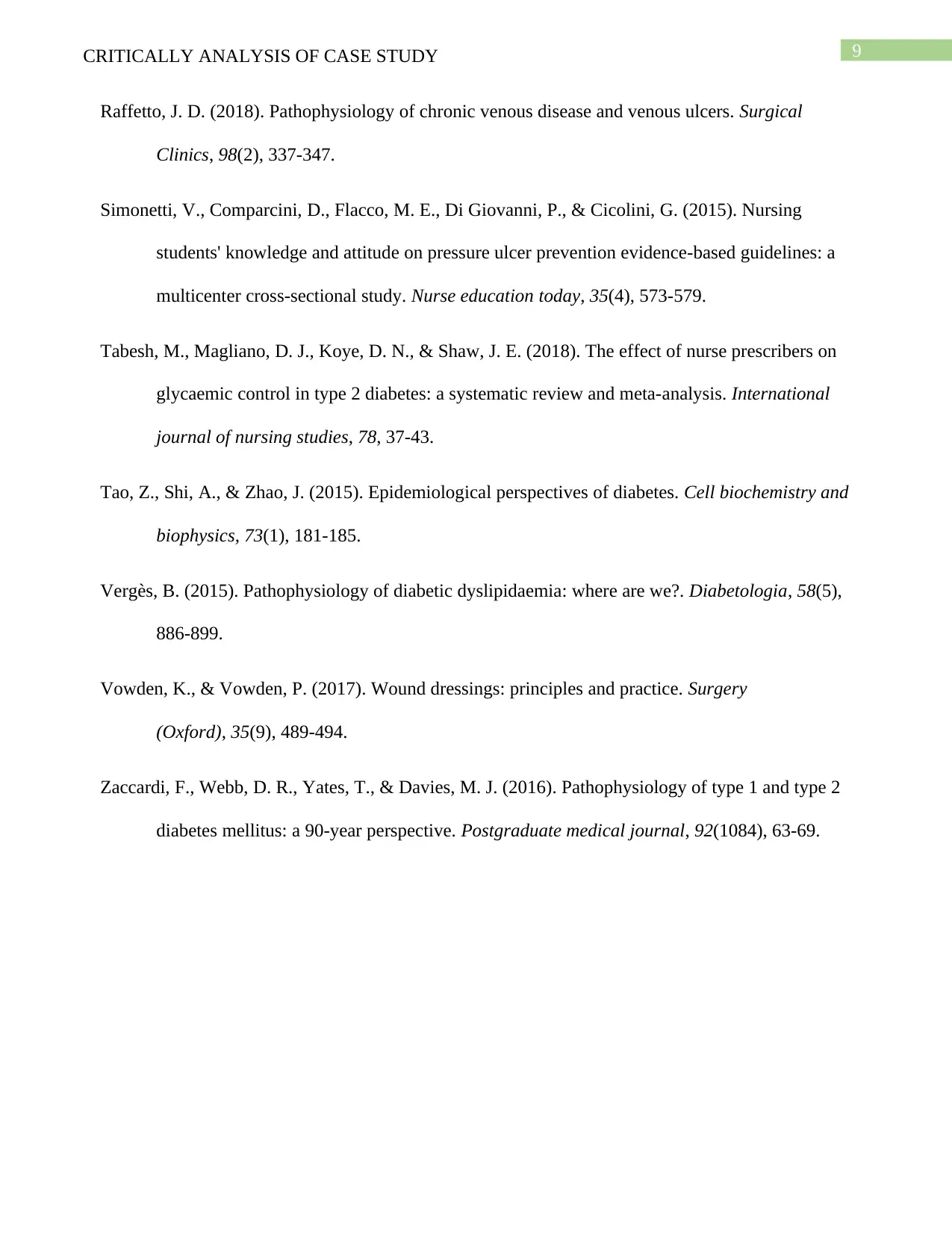
9CRITICALLY ANALYSIS OF CASE STUDY
Raffetto, J. D. (2018). Pathophysiology of chronic venous disease and venous ulcers. Surgical
Clinics, 98(2), 337-347.
Simonetti, V., Comparcini, D., Flacco, M. E., Di Giovanni, P., & Cicolini, G. (2015). Nursing
students' knowledge and attitude on pressure ulcer prevention evidence-based guidelines: a
multicenter cross-sectional study. Nurse education today, 35(4), 573-579.
Tabesh, M., Magliano, D. J., Koye, D. N., & Shaw, J. E. (2018). The effect of nurse prescribers on
glycaemic control in type 2 diabetes: a systematic review and meta-analysis. International
journal of nursing studies, 78, 37-43.
Tao, Z., Shi, A., & Zhao, J. (2015). Epidemiological perspectives of diabetes. Cell biochemistry and
biophysics, 73(1), 181-185.
Vergès, B. (2015). Pathophysiology of diabetic dyslipidaemia: where are we?. Diabetologia, 58(5),
886-899.
Vowden, K., & Vowden, P. (2017). Wound dressings: principles and practice. Surgery
(Oxford), 35(9), 489-494.
Zaccardi, F., Webb, D. R., Yates, T., & Davies, M. J. (2016). Pathophysiology of type 1 and type 2
diabetes mellitus: a 90-year perspective. Postgraduate medical journal, 92(1084), 63-69.
Raffetto, J. D. (2018). Pathophysiology of chronic venous disease and venous ulcers. Surgical
Clinics, 98(2), 337-347.
Simonetti, V., Comparcini, D., Flacco, M. E., Di Giovanni, P., & Cicolini, G. (2015). Nursing
students' knowledge and attitude on pressure ulcer prevention evidence-based guidelines: a
multicenter cross-sectional study. Nurse education today, 35(4), 573-579.
Tabesh, M., Magliano, D. J., Koye, D. N., & Shaw, J. E. (2018). The effect of nurse prescribers on
glycaemic control in type 2 diabetes: a systematic review and meta-analysis. International
journal of nursing studies, 78, 37-43.
Tao, Z., Shi, A., & Zhao, J. (2015). Epidemiological perspectives of diabetes. Cell biochemistry and
biophysics, 73(1), 181-185.
Vergès, B. (2015). Pathophysiology of diabetic dyslipidaemia: where are we?. Diabetologia, 58(5),
886-899.
Vowden, K., & Vowden, P. (2017). Wound dressings: principles and practice. Surgery
(Oxford), 35(9), 489-494.
Zaccardi, F., Webb, D. R., Yates, T., & Davies, M. J. (2016). Pathophysiology of type 1 and type 2
diabetes mellitus: a 90-year perspective. Postgraduate medical journal, 92(1084), 63-69.
1 out of 10
Related Documents
Your All-in-One AI-Powered Toolkit for Academic Success.
+13062052269
info@desklib.com
Available 24*7 on WhatsApp / Email
![[object Object]](/_next/static/media/star-bottom.7253800d.svg)
Unlock your academic potential
© 2024 | Zucol Services PVT LTD | All rights reserved.





